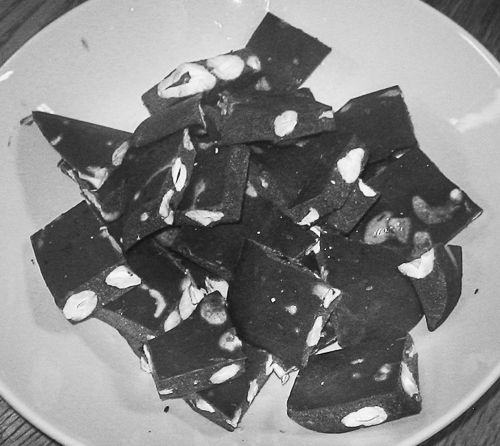I went recently to a chocolate-making course in order to find out how it’s made. The course was one of many events, which took place during the annual Eco-week in the town where I live.
The word “chocolate” entered English from Spanish, but it’s uncertain how the word entered Spanish. Anyway, what is not in doubt is that Spanish soldiers, called conquistadors , encountered Indians, like the Aztecs, who were certainly drinking cold chocolate liquor and using cocoa beans as a form of currency in the early 1500s.
The course was held in the kitchen of a local school having enough space for all the participants, about 15 in all. The course was run by a young couple who have started their own company called Økosjokolade, which means Eco-chocolate. They started their company in 2008 buying cocoa directly from farmers in Peru who grow Criollo cocoa trees organically. Only about 5-10% of the world’s chocolate is made from Criollo cocoa because Criollo trees have a low resistance to diseases. Instead, it has been replaced with Forastero and Trinatario trees.
The customers of Økosjokolade consist mainly of people who want to know as far as possible what they are eating, consisting of ingredients which have been grown without using pesticides and modified as little as possible, possibility to select their own sweeteners and that the producers have been paid pay fairly for their work.
The products of Økosjokolade include, among other things, the following:
– cocoa butter, which is extracted by compressing cocoa beans and cocoa powder, which is made by grinding beans after they have been compressed.
– sweeteners like agave syrup and yacón syrup. nut butter of cashew, pecan, almond and others.
– nuts and dried fruit like dates, walnuts, raisins and many others.
– moulds for chocolate and confectionery.
In short, they sell everything to make your chocolate whatever your taste and preferences.
After the introduction, we formed teams of 2 and 3, finding a recipe at each workplace. First, we should weigh exact amounts of chocolate powder and chocolate butter on a digital scales. We put both in a glass bowl and we poured hot water in another bowl, then putting the first bowl into the first one, letting the hot water melt the cocoa and stirring carefully until everything had been turned into chocolate liquor. After having poured the liquor into a mould, we grated the peel of an orange over the chocolate liquor, giving its surface orange spots and putting it in a freezer in the end.
During the break, we were shown how to make chocolate balls rolled in liquorice, which we were immediately served.
After about one hour we took them out again. Since we had made so much, we could taste the chocolates of the other participants. Some of the chocolates contained various mixtures of nuts, while other ones contained dried fruits and berries. A real treat! The best of all was that we had made so much chocolate that we could bring samples of all the chocolates back home.
The Økosjokolade company have the following three bases: fair trade, organic cocoa cultivation and wholesomeness.
- Fair trade: buying cocoa products direct from a cooperative in Peru and paying the farmers fairly. Moreover, the cocoa beans are transformed into cocoa powder and cocoa butter by the cooperative, letting as much income as possible stay locally and avoiding middlemen.
- Organic cultivation: avoiding pesticides and insecticides, some of which may be forbidden from use in developed countries and exported to poor countries.
- Wholesomeness: by making one’s own chocolate, it’s possible to keep the healthy effects of cocoa and replace sugar and any other possibly harmful ingredients with better alternatives.
If you want to make drink using cocoa as one of the ingredients, the following recipe can be used for making horchata.

